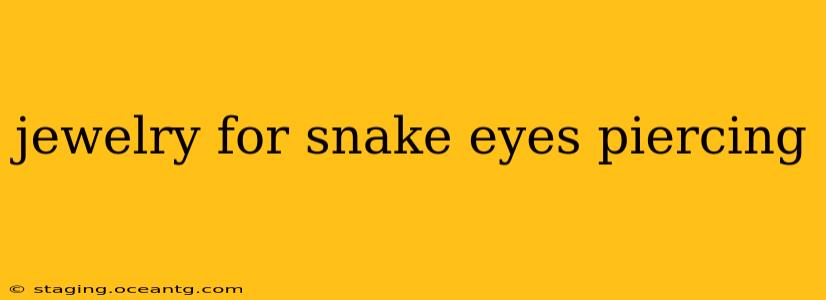Snake eyes piercings, also known as double nostril piercings, are a trendy and stylish way to enhance your facial features. Choosing the right jewelry is crucial for both aesthetic appeal and healing. This guide will explore various jewelry options, materials, and considerations for your snake eyes piercings.
What are the best materials for snake eyes piercings?
The ideal material for newly pierced snake eyes is biocompatible, meaning it won't cause irritation or allergic reactions. The most recommended materials include:
- Implant-grade titanium: This is a top choice because of its biocompatibility, durability, and resistance to corrosion. It's hypoallergenic and less likely to cause issues during the healing process.
- Surgical steel (316L): A more affordable option than titanium, surgical steel is also biocompatible and relatively durable. However, it's not as resistant to corrosion as titanium.
- Niobium: Similar to titanium in its biocompatibility and hypoallergenic properties, Niobium is also a strong and durable material.
- Gold (14k or 18k): Solid gold, particularly 14k or 18k, is also biocompatible, but it can be more expensive. Ensure it's solid gold and not gold-plated.
Materials to avoid during healing:
Avoid materials like nickel, cheap metals, and plated jewelry during the healing phase, as they can easily cause irritation, infections, or allergic reactions.
What types of jewelry are suitable for snake eyes piercings?
Several jewelry types work well for snake eyes piercings. The best choice often depends on personal preference and the piercer's recommendation.
- Small rings: These are a classic and popular choice. They should be seamless (no closures) for easier insertion and cleaning, particularly during healing. Look for small, thin rings to prevent discomfort.
- Small studs: These can offer a more subtle look than rings. Choose small studs with flat backs to minimize irritation.
- Labrets: While less common for snake eyes specifically, small labrets (straight barbells) could work if the piercings are close enough together.
What gauge (thickness) of jewelry should I use?
The gauge of your jewelry depends largely on your piercer's recommendation. However, for initial piercings, you'll likely want a gauge between 18g and 20g. Smaller gauges (thicker jewelry) are usually preferable for initial piercings as they offer more support during healing. After healing, you can possibly switch to smaller gauges, but always consult your piercer.
How long should I wait to change my snake eyes jewelry?
You should never change your snake eyes jewelry yourself during the healing period. Let your piercer determine when it's safe to change your jewelry, typically after the piercings are fully healed, which can take several months. This will typically be 6-12 months for the vast majority of people.
What should I look for when buying snake eyes piercing jewelry?
When purchasing jewelry for snake eyes piercings, consider the following:
- Biocompatibility: Choose jewelry made from biocompatible materials like implant-grade titanium, niobium, or solid gold.
- Quality: Buy from reputable jewelers specializing in body jewelry.
- Size and gauge: Select the appropriate size and gauge as recommended by your piercer.
- Seamless design: Opt for seamless rings or studs for easier cleaning and less irritation during healing.
- Comfort: Ensure the jewelry is comfortable to wear and doesn't cause excessive pressure or discomfort.
Can I use fake jewelry for my snake eyes piercing?
No. Fake jewelry should absolutely not be used. Avoid any jewelry that isn't made of safe, biocompatible materials. Cheap or inappropriate jewelry can cause serious infections and complications that could permanently damage your piercings and leave scarring.
By following these guidelines and prioritizing safe practices, you can ensure your snake eyes piercings heal properly and look fantastic! Remember, always consult your piercer for personalized advice and recommendations. They are the best source of information regarding your specific piercing and aftercare.
